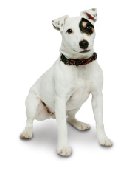Dog Jumping Problems: How to Make It Stop!
Dogs like to jump. When you watch a group of dogs at play you'll see them jump all over one another, perfectly okay in the doggie world. However, in the human world, it's considered impolite and dogs need to learn how to greet humans in a manner that's acceptable to people. With consistency and lots of positive reinforcement, your dog's jumping problems can be a thing of the past.
Every dog responds to different things. One training method may work wonders with one dog, while it has no effect on another. So below is a list of some techniques to try. Positive reinforcement dog training is key - do not punish! Dogs learn to repeat behavior when they're rewarded for it, so encourage and reward your dog throughout the training process.
Technique #1: Turn Your Back
As you come in the door, you're likely expecting your dog to jump up on you in greeting and in pure excitement. Before she jumps, turn your back on her and ignore her wild jumping. Discretely keep an eye on her. The instant she puts all four paws back down on the ground, turn around and greet her calmly and with a brief, "Good dog!" or something similar. Try not to over-excite her again. If she attempts to jump on you again, then turn
your back again. Repeat as necessary. You want to
teach her that staying down on the ground means
she'll get attention, while jumping up means she'll
get ignored.
If she attempts to jump on you again, then turn
your back again. Repeat as necessary. You want to
teach her that staying down on the ground means
she'll get attention, while jumping up means she'll
get ignored.
This may take a while... but practice makes perfect! Be consistent and don't get frustrated. Remember that timing is important - you should greet / praise your pup when all four of her paws are on the ground, not when she's jumping on you.
Technique #2: The Sit/Stay or 'Off'
As the title suggests, this involves teaching your dog to sit quietly whenever someone comes to the door. She stays in that position until you give her your "release word" (use anything you want, just be consistent, eg. "okay", "let's go", etc).Teaching this method is actually very similar to the first. Before you begin, your dog should already know how to sit/stay in a normal, calm situation. Now you want her to do it when one of the most exciting things happen - a visitor comes to the door! When your dog jumps on you, ignore her. Wait until her paws are all on the ground, and then say a command, such as "off". Then greet / praise her. Make sure you wait until her paws are on the ground before you give her the command - you want her to associate the command with keeping her paws on the ground, not with jumping up on you!
If you like, you can take the training a bit further. Once her paws are on the ground, ask her to do a sit/stay. After your dog holds a sit/stay, you can have her either offer her paw on cue, or give a single greeting bark. This will give your dog something to think about (and dog lovers find it irresistable).
Technique #3: Go Get a Toy!
This is a great method for dogs that like to have a "job" to do. First, train your dog to retrieve a toy on command (in a normal, calm situation). Once he understands and can do so reliably, then you move onto getting him to fetch a toy when someone comes to the door.This will give your dog something to do and use up a bit of energy... plus the dog may be so happy and preoccupied with the toy that he won't be so inclined to jump on you in greeting. Plus it's cute!
Technique #4: Tempting with Treats
If you have a dog that's food-motivated, you will probably find this method the easiest. Carry tasty treat tidbits with you, or keep a stash near the door. When you come in the door, pick up some treats. Ignore your dog's jumping (he might be even more enthuastic now that he senses food!). Once he puts all four paws on the ground - or responds to your command of "Sit!" - instantly reward him with the treats and with your attention.The Difference Between "Off" and "Down"
Many people use these two commands interchangeably, but it can be confusing for your dog. "Down" usually means "lie down", while "off" is most often used when you want the dog to get off something like a piece of furniture, the counters, the cat, etc.Dog jumping problems aren't an uncommon behavior problem ... but fortunately, they're usually not difficult to correct either. The keys are to be consistent with your training; to make sure you get the timing of rewards right; and to make the experience a positive one for both you and your dog.
